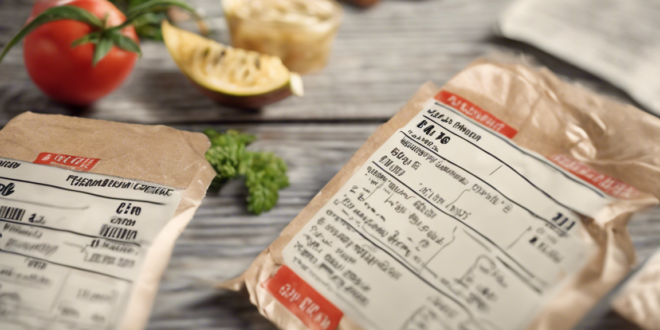Front-of-Package Food Labels: A Smart Path to Healthier Nutritional Choices
In the complex landscape of modern nutrition, consumers face an overwhelming array of food choices that can significantly impact their health and well-being. Front-of-package (FOP) food labels have emerged as a critical tool in helping Americans make more informed and healthier dietary decisions. These innovative labeling systems provide clear, concise information about nutritional content, potentially transforming how we understand and select our food products.
Understanding the Importance of Front-of-Package Labeling
Modern food packaging can be incredibly confusing, with complex nutritional information often hidden in small print on the back of products. Front-of-package labels represent a revolutionary approach to nutrition communication, offering consumers immediate, easy-to-understand insights into the nutritional value of their food choices. By presenting key nutritional information prominently and clearly, these labels empower individuals to make more health-conscious decisions quickly and efficiently.
The Science Behind Nutritional Labeling
Decades of nutritional research have demonstrated that consumers struggle to interpret traditional nutrition labels. The complexity of detailed nutritional information often leads to confusion and misunderstanding. Front-of-package labels address this challenge by distilling complex nutritional data into simple, visually accessible formats that can be quickly comprehended by shoppers of all ages and backgrounds.
Key Benefits of Front-of-Package Food Labels
1. Immediate Nutritional Awareness
Front-of-package labels provide instant visibility into a product’s nutritional profile. At a glance, consumers can assess critical elements such as calorie content, sugar levels, and key nutrients without needing to decipher complex nutritional charts.
2. Simplified Decision Making
By presenting information in a clear, standardized format, these labels reduce cognitive load during shopping. Consumers can make faster, more informed choices about the nutritional value of products without feeling overwhelmed by technical details.
3. Promoting Healthier Food Selection
Research indicates that prominent nutritional labeling can encourage consumers to choose healthier food options. When nutritional information is easily visible, individuals are more likely to consider the health implications of their food choices.
Current Challenges in Food Labeling
Despite the potential benefits, the implementation of front-of-package labels is not without challenges. Inconsistent standards, varying design approaches, and potential industry resistance have complicated widespread adoption. Different countries and regions have developed unique labeling systems, creating a fragmented landscape of nutritional communication.
Global Perspectives on Nutritional Labeling
Various countries have adopted different approaches to front-of-package labeling. Some nations utilize color-coded systems, while others employ warning icons or detailed nutritional summaries. The United States has been somewhat slower to implement comprehensive national standards compared to countries like Chile, Mexico, and several European nations.
Emerging Technologies and Future Directions
Technological advancements are revolutionizing nutritional labeling. Smartphone applications, augmented reality, and digital scanning technologies are creating new opportunities for consumers to access detailed nutritional information instantly. These innovations promise to make nutritional information more accessible and personalized than ever before.
Consumer Education and Nutritional Literacy
While improved labeling is crucial, it must be accompanied by comprehensive consumer education. Understanding how to interpret nutritional information, recognize healthy choices, and make informed dietary decisions remains a critical component of public health strategy.
Policy Recommendations
To maximize the effectiveness of front-of-package labels, policymakers should consider:
– Developing standardized, clear labeling guidelines
– Ensuring consistency across different food categories
– Implementing mandatory nutritional disclosure
– Supporting ongoing research into label design and consumer comprehension
The Role of Industry in Nutritional Transparency
Food manufacturers play a pivotal role in promoting nutritional transparency. By voluntarily adopting clear, comprehensive front-of-package labeling, companies can demonstrate commitment to consumer health and build trust with increasingly health-conscious consumers.
Conclusion: A Pathway to Better Nutrition
Front-of-package food labels represent more than just a technical innovation—they are a powerful tool for public health education. By providing clear, accessible nutritional information, these labels empower consumers to make more informed dietary choices, potentially reducing the burden of diet-related health issues.
As our understanding of nutrition evolves and technology advances, front-of-package labels will continue to play an increasingly important role in promoting health and well-being. Consumers, industry leaders, and policymakers must collaborate to develop and implement effective, user-friendly nutritional communication strategies.
 Good Calories Guide GoodCalories Guide focuses on nutrition, healthy eating, and overall wellness. The site offers practical insights into evidence-based dietary practices, including tips for specific lifestyles such as veganism, keto, and family-friendly meal planning. It also addresses unique nutritional needs for individuals with conditions like diabetes or food allergies, while providing quick and accessible recipes to make healthy living a sustainable and enjoyable choice.
Good Calories Guide GoodCalories Guide focuses on nutrition, healthy eating, and overall wellness. The site offers practical insights into evidence-based dietary practices, including tips for specific lifestyles such as veganism, keto, and family-friendly meal planning. It also addresses unique nutritional needs for individuals with conditions like diabetes or food allergies, while providing quick and accessible recipes to make healthy living a sustainable and enjoyable choice.


